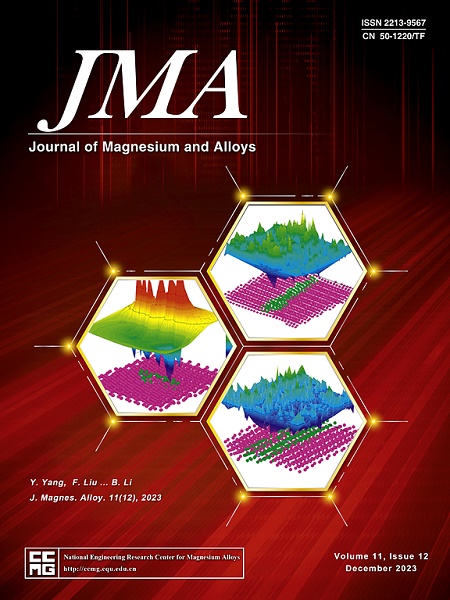Achieving excellent mechanical properties in Mg-5Bi-3Al alloy via ultra-fine grain and high-density precipitates
IF 15.8
1区 材料科学
Q1 METALLURGY & METALLURGICAL ENGINEERING
引用次数: 0
Abstract
The development of low-cost, high-performance Mg alloys is crucial to the industrial applications of large-scale production of Mg alloys. In this work, extruded Mg-5Bi-3Al alloy with excellent mechanical properties is successfully prepared by modifying the extrusion temperatures (240 °C and 300 °C). The extruded alloy obtained ultra-high strength (yield strength = 380 MPa, ultimate tensile strength = 418 MPa) and excellent plasticity (elongation = 10.2%) at the extrusion temperature of 240 °C, the main contributing factors are primarily attributed to the synergistic effect of ultrafine recrystallized grain size (∼0.5 µm) and high density of Mg3Bi2 precipitates. Stacking faults within the sub-micron Mg3Bi2 phase are observed in the E240 alloy, confirming the plastic deformation capability of Mg3Bi2 phase. The effects of extrusion temperature on the microstructure, mechanical properties, and work-hardening behavior of the extruded Mg-5Bi-3Al alloys at room temperature are systematically investigated. The results suggest that decreasing the extrusion temperature can refine recrystallized grain size and Mg3Bi2 phase size, and the quantity of Mg3Bi2 phase is increased, while increasing the extrusion temperature can improve the degree of recrystallization and weaken texture. The work hardening rate is increased with the increased extrusion temperature, mainly due to the coarsening of grains and precipitates, and the weakening of texture. This work provides an experimental basis for preparing high-performance wrought Mg-5Bi-3Al alloys.
通过超细晶粒和高密度析出物实现 Mg-5Bi-3Al 合金的优异机械性能
本文章由计算机程序翻译,如有差异,请以英文原文为准。
求助全文
约1分钟内获得全文
求助全文
来源期刊

Journal of Magnesium and Alloys
Engineering-Mechanics of Materials
CiteScore
20.20
自引率
14.80%
发文量
52
审稿时长
59 days
期刊介绍:
The Journal of Magnesium and Alloys serves as a global platform for both theoretical and experimental studies in magnesium science and engineering. It welcomes submissions investigating various scientific and engineering factors impacting the metallurgy, processing, microstructure, properties, and applications of magnesium and alloys. The journal covers all aspects of magnesium and alloy research, including raw materials, alloy casting, extrusion and deformation, corrosion and surface treatment, joining and machining, simulation and modeling, microstructure evolution and mechanical properties, new alloy development, magnesium-based composites, bio-materials and energy materials, applications, and recycling.
 求助内容:
求助内容: 应助结果提醒方式:
应助结果提醒方式:


